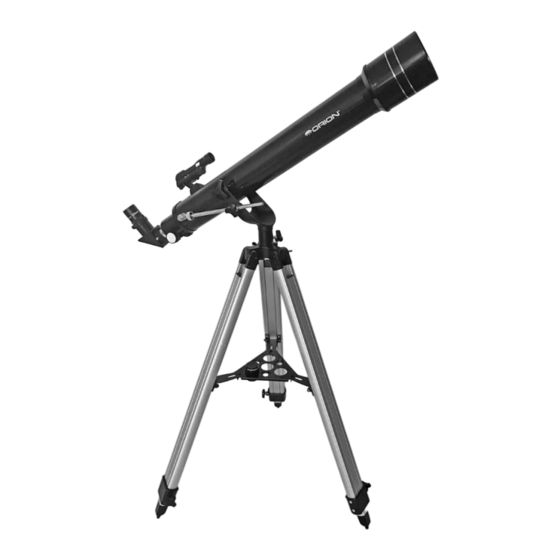
Advertisement
INSTRUCTION MANUAL
Orion
Observer
II 70mm
™
®
Altazimuth Refractor
#10275
®
Customer Support:
www.OrionTelescopes.com/contactus
Corporate Offices:
89 Hangar Way, Watsonville CA 95076 – USA
Providing Exceptional Consumer Optical Products Since 1975
Copyright © 2017 Orion Telescopes & Binoculars
All Rights Reserved. No part of this product instruction or any of its contents may be reproduced, copied,
modified or adapted, without the prior written consent of Orion Telescopes & Binoculars.
IN 580 06/17
Advertisement
Table of Contents

Summary of Contents for ORION TELESCOPES & BINOCULARS Observer II 70mm Altazimuth Refractor
- Page 1 INSTRUCTION MANUAL Orion Observer II 70mm ™ ® Altazimuth Refractor #10275 ® Customer Support: www.OrionTelescopes.com/contactus Corporate Offices: 89 Hangar Way, Watsonville CA 95076 – USA Providing Exceptional Consumer Optical Products Since 1975 Copyright © 2017 Orion Telescopes & Binoculars All Rights Reserved. No part of this product instruction or any of its contents may be reproduced, copied, modified or adapted, without the prior written consent of Orion Telescopes &...
-
Page 2: Table Of Contents
Congratulations on your purchase of an Orion telescope. Your new Observer II 70mm Altazimuth Refractor is a terrific starter instrument for exploring the exotic wonders of the night sky. Designed to be compact and easy to use, it will provide many hours of enjoyment for the whole family. - Page 3 Figure 1. The parts of the Observer II 70 Altaz telescope.
-
Page 4: Assembly
2. Assembly 7. To attach the red dot finder scope (K) to the optical tube, orient the finder scope as shown in Figure 9 and slide the 1. Attach the three aluminum tripod legs (A) to the yoke bracket foot into the finder scope base until it clicks. (To mount (B) (Figure 3a) with the three hinged leg braces fac- remove the finder scope, press the small tab at the back of the base and slide the bracket out.) -
Page 5: Preparing The Telescope For Operation
Accessory tray Screw head Washer Washer Wing nut Figure 4. Thread a leg lock thumbscrew onto each tripod leg as shown, being careful not to overtighten. Figure 5. Attach the accessory tray to each of the tripod three and secure it by lightly tightening the thumbscrew on the leg brace supports using the provided hardware. -
Page 6: Astronomical Observing
Because making fine-adjustments in the altitude of the telescope appear in the field of view somewhere near the red dot. can be difficult, the Observer II 70mm Altazimuth refractor comes equipped with an altitude micro-motion rod and thumbwheel 5. You’ll want to center the target object on the red dot. To do (Figure 12). - Page 7 Eyepiece Yoke knob Focuser Altitude lock drawtube knob Micro-motion rod Thumbscrew Thumbscrew Star diagonal Focus wheel Thumbwheel Figure 10. Figure 12. The micro-motion rod and thumbwheel allow fine Secure the star diagonal in the focuser drawtube with the thumbscrew on the drawtube collar, then install the eyepiece in altitude pointing control.
- Page 8 Focusing the Telescope viewing conditions. Your Observer II 70mm Altazimuth refractor To focus the telescope, turn the focus wheels (Figure 10) comes with 25mm and 10mm Kellner eyepieces, which will suf- forward or back until you see your target object (e.g., stars,...
-
Page 9: Worthwhile Optional Accessories
Jupiter, and Saturn are the brightest objects in the sky after the detail. The filter threads into the bottom of the Kellner eye- pieces that came with your telescope (Figure 13). Sun and the Moon. Other planets may be visible but will likely appear star-like. -
Page 10: Specifications
7. Specifications Objective lens: 70mm (2.8") diameter, achromatic Effective focal length: 700mm Focal ratio: f/10 Lens coatings: Antireflection coated Focuser: Rack-and-pinion, accepts 1.25" accessories Eyepieces: 25mm and 10mm Kellner, antireflection coated, 1.25" barrel diameter, threaded for Orion filters Eyepiece magnification: 28x (with 25mm eyepiece) and 70x (with 10mm eyepiece) Finder scope: Red dot finder scope Mount: Altazimuth yoke...
















Need help?
Do you have a question about the Observer II 70mm Altazimuth Refractor and is the answer not in the manual?
Questions and answers